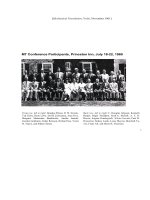Princeton OChem
Bạn đang xem bản rút gọn của tài liệu. Xem và tải ngay bản đầy đủ của tài liệu tại đây (11.79 MB, 257 trang )
~
/Jfle
<...:!,inceton
Review
MCAT
ORGANIC
CHEMISTRY
Peter J. Alaimo
Copyright© 2001 by Princeton Review, lnc. All rights reserved.
Contributors
Peter J. Alaimo, Ph.D.
Senior Author and Editor
DouglasS. Daniels, Ph.D.
Senior Editor
Daniel J. Pallin, M.D.
Adam Johnson
Stefan Loren, Ph.D.
Christopher Volpe, Ph.D.
Steven A. Leduc
Production, Design, and Copy Editor
National Director of MCAT Research, Production, and Development,
The Princeton Review
Copyright© 2001, 2000, 1999, 1998, 1997 by Princeton Review, Inc.
All rights reserved.
Version 3.1
MCAT is a registered trademark of the Association of American Medical Colleges (AAMC).
The Princeton Review is not affiliated with Princeton University or AAMC.
This manual is for the exclusive use of Princeton Review course students,
and is not legal for resale.
~
/J.IJe
~inceton
Review
www.PrincetonReview.com
011001
348
MCAT ORGANIC CHEMISTRY
Table of Contents
Below each chapter title are listed the MCAT topics covered in that chapter. "These topics correspond to those
given in the AAMC's MCAT Student Manual, in the section entitled MCAT Biological Sciences Topics,
Organic Chemistry.
1
Structure and Bonding
Topic XVI
2
Substitution and Elimination Reactions
Topics XIIIA, XIV; XVA
3
Electrophilic Addition Reactions
Topic XV
4
Nucleophilic Addition and Cycloaddition Reactions
Topic XIII
5
Lab Techniques and Spectroscopy
Topics XVII and XVIII
6
Biologically-Important Organic Chemistry
Topic XII
349
PERIODIC TABLE OF THE ELEMENTS
-
2
1
He
H
1.0
3
Li
6.9
11
Na
5
4
B
Be
10.8
9.0
13
12
Mg
23.0
24.3
19
20
21
22
23
24
Ti
v
1~0
1fo
8
0
16.0
AI
Si
14
15
16
27.0
28.1
31.0
31
32
33
Fe
27
Co
28
Ni
Cu
Zn
Ga
Ge
Cr
25
Mn
26
29
30
p
s
9
F
19.0
17
4.0
10
Ne
20.2
18
Cl
Ar
32.1
35.5
39.9
As
34
Se
35
36
Br
Kr
Ca
Sc
39.1
37
40.1
38
45.0
39
47.9
40
52.0
42
54.9
43
55.8
44
58.9
45
58.7
46
63.5
47
65.4
48
69.7
49
74.9
51
79.0
52
79.9
53
83.8
54
y
72.6
50
8~~5
Zr
50.9
41
87.6
88.9
57
91.2
92.9
95.9
(98)
101.1
102.9
106.4
107.9
112.4
114.8
118.7
121.8
127.6
126.9
131.3
73
74
76
77
78
80
81
82
83
K
Sr
55
La*
Cs
1
(223)
226.0 227.0
Fr
Ra
Hf
138.9 178.5
104
89
132.9
87
88
72
Act
Rf
{261)
Nb
Ta
w
180.9 183.9
105
106
Db
Sg
(262)
(263)
58
59
Ce
140.1
t
Mo
90
Th
232.0
Pr
Tc
75
Re
186.2
(231)
190.2 192.2
109
~
60
Nd
u
238.0
Rh
lr
Os
(2
140.9 144.2
91
92
Pa
Ru
)
61
Pm
(145)
Ag
79
Cd
Pt
Au
Hg
195.1
197.0
200.6
In
Tl
Sn
Pb
204.4 207.2
Sb
Te
I
Xe
Bi
Po
84
85
At
Rn
86
209.0
(209)
(210)
(222)
70
71
Mt
{267)
62
Sm
63
Eu
150.4 152.0
93
94
(237)
(244)
Np
Pd
Pu
95
Am
(243)
350
64
Gd
157.3
65
66
67
69
Tb
Dy
158.9
162.5
164.9
167.3
168.9
Ho
Tm
Yb
Lu
173.0 175.0
96
97
98
99
100
101
102
103
(247)
(247)
{251)
{252)
(257)
(258)
(259)
{260)
Cm
Bk
Cf
Es
Fm
Md
No
Lr
MCAT ORGANIC CHEMISTRY
TABLE OF CONTENTS
1 STRUCTURE AND BONDING ................................... 357
BACKGROUND AND INTRODUCTION ............................................. 358
Basic 1\Jomenclature ................................................................................... 358
Principal Classes of Organic Compounds ................................................. 359
BONDING IN ORGANIC MOLECULES ............................................. 360
Hybridization .............................................................................................. 360
a Bonds ...................................................................................................... 363
n Bonds ...................................................................................................... 363
STRUCTURAL FORMULAS ............................................................... 364
BOND LENGTH AND BOND DISSOCIATION ENERGY ................... 365
ISOMERISM AND CHIRALITY ........................................................... 367
Constitutional Isomerism ........................................................................... 367
Conformational Isomerism ......................................................................... 367
Stereoisomerism ........................................................................................ 368
Chirality ...................................................................................................... 369
Absolute Stereocenter Configuration ......................................................... 372
Enantiomers ............................................................................................... 377
Diastereomers ............................................................................................ 378
Epimers ...................................................................................................... 382
Anomers ..................................................................................................... 383
Geometric Isomers .................................................................................... 383
Summary of Isomers .................................................................................. 385
OPTICAL ACTIVITY ............................................................................ 386
Racemic Mixtures and Meso Compounds ................................................. 387
PHYSICAL PROPERTIES OF HYDROCARBONS ............................ 391
Melting and Boiling Points ......................................................................... 391
Solubility ..................................................................................................... 392
THE ORGANIC CHEMIST'S TOOLBOX ............................................ 393
Nucleophiles and Electrophiles ................................................................. 393
Reaction Intermediates .............................................................................. 393
Inductive Effects ......................................................................................... 394
Electron Delocalization and Resonance Stabilization ............................... 395
351
2
SUBSTITUTION AND ELIMINATION REACTIONS ... 405
STRUCTURE AND REACTIVITY
OF ALKANES AND CYCLOALKANES ............................................... 406
Common Structural Notations for Alkanes ................................................ 406
Conformational Analysis of Alkanes and Cycloalkanes ............................. 407
Combustion Reactions of Hydrocarbons ................................................... 417
Free-Radical Halogenation of Alkanes ...................................................... 417
ALCOHOLS ........................................................................................ 425
Structure, Hydrogen Bonding, and Acidity in Alcohols and Phenols ......... 425
Hydrogen Bonding in Alcohols ......................................................................... 425
Acidity of Alcohols ............................................................................................ 427
Substitution Reactions of Alcohols ............................................................ 430
The Details of SN2 Reactions .......................................................................... 430
The Details of SN 1 Reactions ..........................................................................432
Elimination Reactions of Alcohols: Dehydration ........................................ 435
HALO ALKANES ................................................................................. 439
Formation of Haloalkanes .......................................................................... 439
Reactions of Alcohols with Phosphorus Halides ............................................. 439
Reactions of Alcohols with Thionyl Chloride .................................................... 440
Substitution Reactions of Haloalkanes ...................................................... 440
Elimination Reactions of Haloalkanes ....................................................... 441
E1 Reactions .................................................................................................... 441
E2 Reactions .................................................................................................... 443
Summary of Substitutions and Eliminations .............................................. 445
ETHERS ............................................................................................. 445
AMINES .............................................................................................. 446
Alkylation .................................................................................................... 447
352
3
ELECTROPHILIC ADDITION REACTIONS ............... 449
ALKEN ES ........................................................................................... 450
Structure and Nomenclature ...................................................................... 450
Isomerism in Alkanes ....................................................................................... 450
The CisfTrans Convention ............................................................................... 450
The (Z)/(E) Convention ................................................................................... 451
Electrophilic Addition Reactions to Alkenes and Alkynes .......................... 451
H-X Addition Across an Bond ......................................................................... 452
H-Br and Peroxides Addition Across a n Bond ............................................... 454
Acid-Catalyzed Hydration of Alkanes .............................................................. 455
Oxymercuration-Demercuration ...................................................................... 457
Hydroboration-Oxidation ................................................................................. 458
Hydrogenation .................................................................................................. 459
Addition of Halogens (X2 ) to a n Bond ............................................................. 460
Epoxide Formation and Hydrolysis ..................................................................462
Oxidation of n Bonds with Dilute KMnO 4 ......................................................... 463
Ozonolysis ........................................................................................................ 464
AROMATIC COMPOUNDS ................................................................ 468
Aromaticity Defined .................................................................................... 468
Nomenclature of Substituted Benzenes .................................................... 470
Reactivity of Aromatic Compounds:
Electrophilic Aromatic Substitution .......................................................... 470
353
4
NUCLEOPHILIC ADDITION AND
CYCLOADDITION REACTIONS ................................ 475
ALDEHYDES AND KETONES ........................................................... 476
Reactivity: Acidity and Enolization ............................................................. 476
Keto-Enol Tautomerism ................................................................................... 479
Nucleophilic Addition Reactions to Aldehydes and Ketones ..................... 479
Acetals and Hemiacetals ................................................................................. 480
Imine Formation ............................................................................................... 484
The Aldol Condensation ................................................................................... 486
Conjugate Addition to a,~-Unsaturated Carbonyl Corn pounds ................. 490
CARBOXYLIC ACIDS ......................................................................... 493
Acidity and Hydrogen Bonding .................................................................. 493
Inductive Stabilization of Carboxylate Ions by
Electron-Withdrawing Groups ........................................................................ 493
Hydrogen Bonding in Carboxylic Acids ........................................................... 495
Decarboxylation Reactions of ~-Keto Acids .............................................. 495
Esterification Reactions ............................................................................. 495
CARBOXYLIC ACID DERIVATIVES ................................................... 497
Acidic and Basic Hydrolysis of Esters ....................................................... 498
Saponification ................................................................................................... 501
Synthesis of the Carboxylic Acid Derivatives ............................................ 502
Acid Halides ..................................................................................................... 502
Carboxylic Acid Anhydrides ............................................................................. 502
Esters ............................................................................................................... 503
Amides ............................................................................................................. 503
Carboxylic Acids ............................................................................................... 503
Relative Reactivity of Carboxylic Acid Derivatives .................................... 503
CONCERTED REACTIONS ............................................................... 505
Diels-Aider ................................................................................................. 505
354
5
LAB TECHNIQUES AND SPECTROSCOPY ............. 507
SEPARATIONS ................................................................................... 508
Extractions ................................................................................................. 508
Crystallization and Precipitation ................................................................ 512
Chromatography ........................................................................................ 512
Thin-Layer Chromatography ............................................................................ 512
Gas Chromatography ....................................................................................... 514
Distillations ................................................................................................. 515
Simple Distillation ............................................................................................. 515
Fractional Distillation ........................................................................................ 515
SPECTROSCOPY .............................................................................. 516
Infrared (IR) Spectroscopy ......................................................................... 517
Important Stretching Frequencies ................................................................... 518
Summary of Infrared {IR) Stretching Frequencies .......................................... 521
Proton CH) Nuclear Magnetic Resonance (NMR) Spectroscopy .............. 522
Chemically Equivalent Protons ........................................................................ 522
The Chemical Shift ........................................................................................... 523
Electronegativity Effects on Chemical Shift Values .................................. 524
Hybridization Effects on Chemical Shift Values ....................................... 524
Acidity and Hydrogen Bonding Effects on Chemical Shift Values ........... 525
Integration ........................................................................................................ 527
Splitting ............................................................................................................ 527
355
6
BIOLOGICALLY-IMPORTANT
ORGANIC CHEMISTRY ............................................. 531
AMINO ACIDS .................................................................................... 532
Amino Acid Structure and Nomenclature ................................................... 532
Amino Acid Reactivity ................................................................................ 535
Classification of Amino Acids ..................................................................... 539
Hydrophobic Amino Acids ................................................................................ 540
Hydrophilic Amino Acids .................................................................................. 541
Sulfur-Containing Amino Acids ........................................................................ 543
Proline .............................................................................................................. 543
PROTEINS ......................................................................................... 545
The Peptide Bond ...................................................................................... 545
The Disulfide Bond .................................................................................... 548
Protein Structure in Three Dimensions ...................................................... 549
Primary Structure ............................................................................................. 549
Secondary Structure ........................................................................................ 549
Tertiary Structure .............................................................................................. 550
Quaternary Structure ....................................................................................... 552
CARBOHYDRATES ............................................................................ 553
Structure and Nomenclature of Monosaccharides .................................... 553
Structure and Nomenclature of Disaccharides .......................................... 559
Reducing Sugars ....................................................................................... 562
LIPIDS ................................................................................................ 563
STEROl DS ......................................................................................... 569
NUCLEIC ACIDS ................................................................................ 570
Phosphorus-Containing Compounds ......................................................... 570
Nucleotides ................................................................................................ 571
A APPENDIX .................................................................... 573
SUMMARY OF REACTIONS ............................................................. 574
356
A'fyp;;,-:f;;;s,-=;;;,-;g MCAT Organic Chemistry
Structure
and
Bonding
1.1 Background and Introduction I 358
1.1.1 Basic Nomenclature I 358
1.1.2 Principal Classes of Organic Compounds I 359
1.2 Bonding in Organic Molecules I 360
1.2.1 Hybridization I 360
1.2.2 a Bonds I 363
1.2.3 n Bonds I 363
1.3 Structural Formulas I 364
1.4 Bond Length and Bond Dissociation Energy I 365
1.5 Isomerism and Chirality I 367
1.5.1 Constitutional Isomerism I 367
1.5.2 Conformational Isomerism I 367
1.5 .3 Stereoisomerism I 368
1.5.4 Chirality I 369
1.5.5 Absolute Stereocenter Configuration I 372
1.5.6 Enantiomers I 377
1.5.7 Diastereomers I 378
1.5.8 Epimers I 382
1.5.9 Anomers I 383
1.5.10 Geometric Isomers I 383
1.5.11 Summary of Isomers I 385
1.6 Optical Activity I 386
1.6.1 Racemic Mixtures and Meso Compounds I 387
1.7 Physical Properties of Hydrocarbons I 391
1.8 The Organic Chemist's Toolbox I 393
1.8.1 Nucleophiles and Electrophiles I 393
1.8.2 Reaction Intermediates I 393
1.8.3 Inductive Effects I 394
1.8.4 Electron Delocalization and Resonance Stabilization I 395
358
MCAT Organic Chemistry
Chapter 1
1.1 Background and Introduction
This section covers the fundan1entals of nomenclature in organic chemistry. Although this section
will require memorization as your primary study technique, it is in your best interest to be
comfortable reading, heating, and using this terminology. Although most of the terminology that
appears on the MCAT is IUPAC, some common nomenclature is also used.
1.1.1 Basic Nomenclature
Carbon Chain Prefixes
Number of carbon
atoms in a row
1
2
3
4
5
6
7
8
9
10
Prefix
methethpropbutpenthexheptoctnondec-
In the case of an all-carbon containing ring, these are preceded by the prefix cyclo-. Hence, a sixmembered ring containing all-CH2- units is called cyclohexane.
Common and IUPAC Nomenclature for Carbon Side-Chains
Common name
IUPACname
R-CH 3
Methyl
Methyl
R-CH 2CH 3
Ethyl
Ethyl
R-CH 2CH 2CH 3
n-Propyl
Propyl
R-CHCH 3
Isopropyl
1-Methylethyl
R-CH 2CH 2CH 2 CH 3
n-Butyl
Butyl
sec-Butyl
1-Methylpropyl
CH3
I
CH3
I
R-CHCH 2 CH3
Structure and Bonding
MCAT Organic Chemistry
CH3
I
R-CH 2 CHCH3
359
Isobutyl
2-Methy lpropyl
tert-Butyl
1,1-l)innethylethyl
Phenyl
Phenyl
Benzyl
Benzyl
CH3
I
R-C-CH
I
3
CH 3
o-R
R
\Q)--1
1.1.2 Principal Classes of Organic Compounds
R--H
R2C=CR2
Rc==cR
alkane
alkene
alkyne
R--x
R--OH
alkyl halide
alcohol
Q-oH
R--0--R
ether
phenol
0
0
0
R--C--R
II
R--C--H
II
R--C--OH
II
R--C--OR
ketone
aldehyde
carboxylic acid
ester
0
0
0
0
II
0
l
II
R--e--x
R2C--CR2
1\
R--C--0-C--R
acid halide
epoxide
acid anhydride
II
0
R--N--R
I
R
amine
II
R--C--N--R
I
R
amide
R =alkyl group =hydrocarbon substituent group (or H)
\/R
/\
R
OR
acetal
R
OR
\I
c
/\OH
R
hemiacetal
X =halogen (F, Cl, Br, I)
MCAT Organic Chemistry
Chapter 1
360
1.2 Bonding in Organic Molecules
The chemistry of organic molecules is dominated by the reactivity of covalent bonds. An
understanding of the fundamentals of covalent bonding can provide the intuitive grasp necessary to
answer a wide range of questions in organic chemistry. This chapter will briefly outline the basic
principles that must be mastered in order to successfully complete organic chemistry passages on
the MCAT. These include hybridization, sigma (cr) bonding, pi (n) bonding, structural formulas,
electron delocalization, resonance stabilization, bond length, bond energy, isomerism, chirality, and
optical activity.
1.2.1 Hybridization
In order to rationalize observed chemical and structural trends, chemists developed the concept of
orbital hybridization. In this model, one imagines a mathematical con1bination of atomic orbitals
centered on the same atom to produce a set of composite, hybrid orbitals. For example, consider an
s and a p orbital on an atom.
0
combined with
p
s
Schematic addition of an s and a p
orbital to form an sp hybrid.
The + and - refer to the sign of the
wave function and not to charges.
sp hybrid
Notice that the new orbital is highly directional; this allows for better overlap when bonding. There
will be two such sp hybrid orbitals formed because two orbitals (the s and the p) were originally
combined; that is, the total number of orbitals is conserved in the formation of hybrid orbitals. For
this reason, the number of hybrid orbitals on a given atom of hybridization s[Y is 1 + x (1 for the s,
361
Structure and Bonding
MCAT Organic Chemistry
x for the p's). The percentages of the s character and p character in a given spx hybrid orbital are
listed below:
spx hybrid orbital
1
s character== - 1+x
X
p character == - 1+x
sp
50%
50%
sp2
33%
67%
sp3
25%
75%
To determine the hybridization for most atoms in simple organic molecules, add the number of
attached atoms to the number of non-bonding electron pairs (non-delocalized) and use the brief
table below (which also gives the bond angles and idealized molecular geometry). Notice that the
number of attached atoms plus the number of non-bonding electron pairs is equal to the number of
orbitals combined to make the new hybridized orbitals.
#attached atoms +
#non-bonding electron pairs
(non-delocalized)
Hybridization
Bond t;mgles (ideal)
Molecular geometry
2
180°
linear
3
120°
trigonal planar
4
109.5°
pyramidal,
tetrahedral,
or bent
sp hybridization
sp hybridized oxygen
( 1 attached atom and
1 unshared electron pair)
.
I.
G·c===o·e
-
I
sp hybridized carbon
(1 attached atom and
1 unshared electron pair)
sp hybridized nitrogen
(1 attached atom and
1 unshared electron pair)
I
H-e-N:
I
sp hybridized carbon
(2 attached atoms and
0 unshared electron pair)
362
Chapter 1
MCAT Organic Chemistry
sp 2 hybridization
0
H
•N / - sp2 hybridized nitrogen
II
l
/c~
H 3C
CH3
sp2 hybridized carbon
(3 attached atoms and 0
unshared electron pairs)
II
C
(2 attached atoms and 1
unshared electron pair)
H / "'cH 3
sp 3 hybridization
Tetrahedral:
H
lr-
H-C-H
sp3 hybridized carbon
(4 attached atoms and 0
unshared electron pairs)
H
-~I
/ C '""''uuu H
H
I
\
H
H
Pyramidal:
.. /
H-N-H
~
sp3 hybridized nitrogen
(3 attached atoms and 1
unshared electron pair)
Bent:
..
H-0..
sp3 hybridized oxygen
(2 attached atoms and 2
unshared electron pairs)
(i}f?
: f'''''''''H
H
MCAT Organic Chemistry
363
Structure and Bondins
1.2.2 Sigma (a) Bonds
A a bond consists of two electrons that are localized between two atomic nuclei. It is formed by the
end-to-end overlap of one hybridized orbital (or an s orbital in the case of hydrogen) from each of
the two atoms participating in the bond.
H
\
I
I
\
H
H-C-C-H
H
H
1.2.3 Pi (n) Bonds
A 1t bond is composed of two electrons that are localized to the region that lies on opposite sides of
the plane formed by the two bonded nuclei and immediately adjacent atoms (not directly between
the two nuclei as with a cr bond). A n bond is formed by the proper parallel side-to-side alignment
of two unhybridized p orbitals on adjacent atoms.
1t
bond
In any multiple bond, there exists only one cr bond; the remainder are
rc bonds. Therefore, a
single bond is composed of one cr bond, a double bond consists of one cr bond and one n bond,
and a triple bond is composed of one cr bond and two n bonds.
364
MCAT Organic Chemistry
Chapter 1
Example 1.
Count the number of cr bonds and
(a)~
(b)
1t
bonds in each of the following molecules.
0
A
CH3
(c)
H
CH3
H
H
rc
(J
-'"""--'-(J
H
rc
_·- - (J
0
0
(e)
(d)
H
0
_,_'>_
(J
(J
__...__ (J
--+-
rc
Solution. Don't forget to count all of the C-H a bonds!
(a) 14
a, 1 n
(b) 9 a, 1 n
(c) 12
a, 2 n
(d) 2 a, 2 n
(e) 27
a, 4 n
(f) 24
a, 7 n
1.3 Structural Formulas
By definition, a molecule is said to be saturated if it contains no n bonds and no rings.
Conversely, a molecule that has at least one n bond or ring is unsaturated. Saturated compounds
have n carbon atoms and exactly 2n + 2 hydrogen atoms. Unsaturated compounds have less than
2n + 2 hydrogen aton1s for their n carbon atoms. The formula below is used to determine the
degree of unsaturation of simple organic molecules. One degree of unsaturation indicates the
presence of one 1t bond or one ring. Two degrees of unsaturation means there are either two 1t
bonds (two separate double bonds or one triple bond), or one n bond and one ring, or two rings;
and so on.
365
Structure and Bonding
MCAT Organic Chemistry
Degree of Unsaturation.
The degree of unsaturation of a molecule gives the total number of rings and
n bonds, and is given by the following formula:
• r
n = number of carbons
~
.
degree of unsaturatwn =
(2n + 2)- x
2
= number Of hydrogens*,
X
.
*The quantity x represents the number of hydrogens and any monovalent
atoms (such as Cl, Br, and I). A halogen atom has a valence of 1 and is
therefore treated the same as a hydrogen. Since the number of oxygens
has no effect, it is ignored. For nitrogen-containing compounds, replace
each N by 1 C and 1 H.
Example 2.
Determine the degree of unsaturation for each of the following molecules:
a) C 6 H 8
b) C 4H 60
c) C 20 H 30 0
d) C 3H 80
e) C 3H 5 B r
Solution.
(a)
(d)
(c)
d
d
(2 x3+2)-8
2
(e)
0. (:. saturated)
d
(2 X 20 + 2)- 30
2
=6.
d= (2x3+2)-(5+1) =1.
2
1.4 Bond Length and Bond Dissociation Energy
While the term bond length makes good intuitive sense (the distance between two nuclei that are
bonded to one another), bond dissociation energy (BDE) is not quite as intuitive. Bond
dissociation energy is the energy required to homolytically break a bond. In homolytic bond
cleavage, one electron of the bond being broken goes to each fragment of the molecule. In this
process two radicals form. This is not the same thing as heterolytic bond cleavage (also known as
dissociation). In heterolytic bond cleavage, both electrons of the electron pair that make up the
bond end up on the same atom; hence, a cation and an anion form.
(CH3)3C-H
______.,...
(CH3)3C·
+ H•
homolytic bond cleavage
(CH3)3C-Cl
______.,...
(CH3)3C+
heterolytic bond cleavage
.. -
+ : Cl:
Chapter 1
366
MCAT Organic Chemistry
These two processes are very different and hence have very different energies associated with them.
Here, we will only consider homolytic bond dissociation energies.
When one examines the relationship between bond length and bond dissociation energy for a
series of similar bonds, an important trend emerges: for similar bonds, the higher the bond order,
the shorter and stronger the bond. This is illustrated in the table below:
BDE
r (in
A)
c-c
C=C
C=C
C-0
C=O
c:=o
83
1.54
144
1.34
200
1.20
86
1.43
191
256
1.13
1.20
BDE = bond dissociation energy (kcal/mol)
r = bond length
An important caveat arises because of the varying atomic radii: bond length/BDE comparisons
should only be made for similar bonds. Thus carbon-carbon bonds should only be compared to
other carbon-carbon bonds. Carbon-oxygen bonds should only be compared to other
carbon-oxygen bonds, and so on.
Recall the shapes of unhybridized atomic orbitals: s orbitals are spherical about the atomic
nucleus while p orbitals are elongated "dumbbell" shaped about the atomic nucleus.
sorbital
0
p orbital
When comparing the same type of bonds, the greater the s character in the component orbitals,
the shorter the bond. A greater percentage of s character leads to a more directional hybrid orbital
which is capable of a higher degree of overlap in bonding. In addition, when comparing the san1e
types of bonds, the longer the bond, the weaker it is; the shorter the bond, the stronger it is. In the
following diagram, compare all the C-C bonds and all the C-H bonds:
Structure and Bonding
MCAT Organic Chemistry
1.06 A
1.46 A
~
~
sp
sp
367
H
/
H--c=c--c~,,
s
--
1.21
A
sp
3
I
''H
~
1.10 A
Bond
C-C (sp- sp)
C-C (sp- sp 3 )
Bond length
Bond
A
1.46 A
1.21
Bond length
C-H (sp- s)
1.o6A
C-H (sp 3 - s)
1.10 A
1.5 Isomerism and Chirality
1.5.1 Constitutional Isomerism
Constitutional (or, less precisely, structural) isomers are compounds that have the same
molecular formula but whose atoms have differing connectivity (are connected together differently).
Take pentane (C 5H 12), for example. n-Pentane is a fully-saturated hydrocarbon that has two
additional structural isomers:
n-Pentane
Isopentane
Neopentane
1.5.2 Conformational Isomerism
Conformational isomers are compounds that have the same molecular formula and the same
atomic connectivity, but which differ from one another by rotation about a (single) cr bond. (For
more on conformational isomers, see Chapter 2.) For the present, however, we introduce three
different notations for representing conformations, using ethane (C 2H6) to illustrate.
Chapter 1
368
MCAT Organic Chemistry
1. Flagged Bond Notation
A staggered conformation
An eclipsed conformation
2. Sawhorse Notation
H
H
H
H
H
H
H
A staggered conformation
An eclipsed conformation
3. Newman Projection
H
H
H
H
A staggered conformation
H
An eclipsed conformation
1.5.3 Stereoisomerism
Stereoisomerism is of major importance in organic chemistry, especially when looking at biological
molecules, so several questions relating to stereochemistry routinely appear on the MCAT.
Stereoisomers are molecules that have the same molecular formula and connectivity but which
differ from one another only in the spatial arrangement of the atoms. They cannot be interconverted
by rotation of a bonds. For example, consider the following two molecules:
Structure and Bonding
MCAT Organic Chemistry
369
CH 3
l
HO"'
111111CI
H
Molecule I
Molecule II
Both molecules have the same molecular formula, C 2H5Cl 0, with the same atoms bonded to each
other. However, if one superimposes II onto I without any rotation, the result is:
Note that while the -CH 3 and -OH groups superimpose, the -Cl and
do not. Likewise, if we
rotate Molecule II 180°, such that the -OH is pointing directly up (12 o'clock) and the -CH 3 is
pointing at about 7 o'clock, and then attempt to superimpose II on I, the result is:
While the -Cl and the -H groups are now superimposable, the -CH3 and the -OH are not. No
matter how one rotates Molecules I and II, two of the substituent groups will be superimposable,
while the other two will not. Hence they are indeed different molecules; stereoisomers.
1.5.4 Chirality
It is important that you are able to identify chiral centers. Any molecule that cannot be
superimposed on its mirror image is said to be chiral. For carbon, a chiral center will have four
different groups bonded to it. Note that since a carbon atom has four different groups attached to it,
it must be sp3 hybridized with (approximately) 109° bond angles and tetrahedral geometry. Such a
carbon atom is also sometimes referred to as an asymmetric center, a stereocenter, or a stereogenic
center. A molecule that can be superimposed on its mirror image has a plane of symmetry and is
said to be achiral.
370
Example 3.
MCAT Organic Chemistry
Chapter 1
Identify all the chiral centers in the following
molecules and determine how
many possible stereoisomers each compound has by placing a star next to each
chiral center.
[The number of possible stereoisomers equals 2n, where n is the
number of chiral centers.]
(d)
3
~CH
(e)
HO
Br
.
HO
(g)o-
OH
(i)
Br
Brh
\___/Br
Solution.
(a) This molecule has no chiral centers.
(b) Since there is one chiral center, there are two possible stereoisomers:
(c) Since there is one chiral center, there are two possible stereoisomers:
CH3
H
H
I
I
H
I* I
I I
CH3 H
H3C-C-C-C-CH3
Structure and Bonding
MCAT Organic Chemistry
371
(d) Since there is one chiral center, there are two possible stereoisomers:
Br
I
;he back carbon
H3C~CH3
H3C/~"-....H
OH
=4 possible stereoisomers:
(e) There are two chiral centers and therefore
(f)
There are two chiral centers, which would seem to indicate 22 = 4 possible stereoisomers.
OH
H
H
H
OH
However, there are only three since the following "two" molecules are actually the same:
{=f
H
H
H
OH
OH
R
H
(g) This molecule has no chiral centers.
(h) There are nine chlral centers and therefore 29 = 512 possible stereoisomers:
OH
( i)
Although there are two chiral centers,
Br
0-Br









